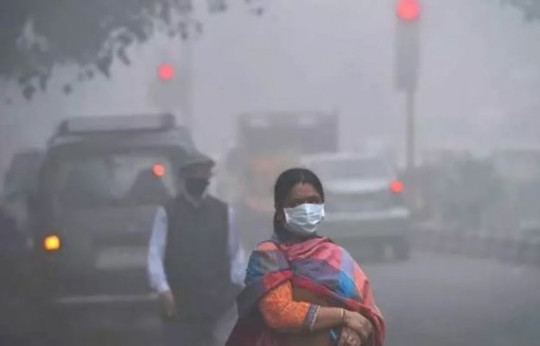#Pollution Levels in Delhi
Explore tagged Tumblr posts
Text
Increase in Pollution Levels in Delhi Due To Firecrackers
New Post has been published on https://majornewshub.com/increase-in-pollution-levels-in-delhi-due-to-firecrackers/
Increase in Pollution Levels in Delhi Due To Firecrackers
दीपावल��� के बाद पटाखों से दिल्ली में प्रदूषण का स्तर बढ़ा
रविवार की देर रात तक पटाखे फोड़ने ��े दिल्ली में प्रदूषण का स्तर काफी बढ़ गया है। दिवाली की रात पटाखों पर प्रतिबंध के बावजूद, निवासियों ने नियमों को तोड़ा, जिसके परिणामस्वरूप सोमवार सुबह धुंध भरा धुआँ और हवा की गुणवत्ता में गिरावट आई।
Pollution Levels in Delhi
दिवाली के दिन, शहर ने शुरू में आठ वर्षों में अपनी सर्वश्रेष्ठ हवा की गुणवत्ता देखी थी, 24 घंटे का औसत वायु गुणवत्ता सूचकांक (AQI) शाम 4 बजे 218 था। हालांकि, पटाखों के लगातार फटने से प्रदूषण के स्तर में तेज वृद्धि हुई।
सुबह 7 बजे तक, AQI 275 तक पहुंच गया था, “खराब श्रेणी” में गिर गया। शादीपुर, अयानगर, लोधी रोड, पूसा और जहांगीरपुरी सहित कुछ क्षेत्रों में AQI 308 से 355 तक होने से “बहुत खराब” श्रेणी में प्रवेश किया गया।
PM2.5 के रूप में ज्ञात ठीक पार्टिकुलेट मैटर, जो श्वसन प्रणाली में गहराई से प्रवेश कर सकता है और स्वास्थ्य समस्याओं को ट्रिगर कर सकता है, इन क्षेत्रों में सुरक्षित सीमा 60 माइक्रोग्राम प्रति घन मीटर से छह से सात गुना अधिक हो गई।
देर रात पटाखे फोड़ने के कारण ओखला और जहांगीरपुरी सहित विभिन्न स्थानों पर PM2.5 की सांद्रता सुबह के शुरुआती घंटों में 1,000 माइक्रोग्राम प्रति घन मीटर से अधिक हो गई।
केंद्रीय प्रदूषण नियंत्रण बोर्ड के आंकड़ों के अनुसार, तुलनात्मक रूप से, दिल्ली में AQI पिछले वर्ष दिवाली पर 312, 2021 में 382, 2020 में 414, 2019 में 337, 2018 में 281, 2017 में 319 और 2016 में 431 दर्ज किया गया था।
दिवाली के एक दिन बाद AQI 2015 में 360 से 2021 में 462 और 2022 में 303 तक रहा है। AQI श्रेणियां “अच्छी” (0-50) से “गंभीर प्लस” (450 से ऊपर) तक होती हैं।
दिल्ली के निवासियों ने सप्ताह के अंत में साफ आसमान और भरपूर धूप का आनंद लिया क्योंकि दिवाली के ठीक पहले हवा की गुणवत्ता में काफी सुधार हुआ था। इस सुधार का श्रेय शुक्रवार को हुई रुक-रुक कर बारिश और प्रदूषक फैलाव के लिए अनुकूल हवा की स्थिति को दिया जाता है।
28 अक्टूबर से शुरू होकर, शहर ने दो सप्ताह तक बहुत खराब से गंभीर हवा की गुणवत्ता का अनुभव किया था, इस अवधि के दौरान राष्ट्रीय राजधानी के ऊपर एक धुंधला धुंध छा गया था।
पिछले तीन वर्षों से, दिल्ली ने दिवाली के दौरान शहर के भीतर पटाखों के निर्माण, भंडारण, बिक्री और उपयोग पर व्यापक प्रतिबंध लगाया है। पिछले साल, पराली जलाने में कमी, देर से बारिश, अनुकूल मौसम की स्थिति और एक प्रारंभिक दिवाली ने शहर को त्योहार के बाद गंभीर वायु प्रदूषण का अनुभव करने से रोका।
एक संख्यात्मक मॉडल-आधारित ढांचा, निर्णय समर्थन प्रणाली, ने अनुमान लगाया कि पड़ोसी राज्यों, विशेष रूप से पंजाब और हरियाणा में पराली जलाने से रविवार को दिल्ली में PM2.5 प्रदूषण.
Read Gold Price Rate Today
0 notes
Text
जानलेवा हुई दिल्ली: 40% लोग छोड़ना चाहते हैं शहर, सर्वे में चौंकाने वाला खुलासा

हाईलाइट
40% लोग छोड़ना चाहते है दिल्ली
एक साल में 5% बढ़ा आंकड़ा
दिल्ली में प्रदूषण जानलेवा हो गया है। सरकार ने स्कूलों को बंद कर दिया है। आज (सोमवार) से प्रदूषण को रोकने के लिए ऑड-इवन नियन भी लागू कर दिया है। इस बीच ऑनलाइन वेबसाइट लोकल सर्किल्स(Localcircles) का सर्वे सामने आया है। इस सर्वे में चौंकाने वाले खुलासे हुए हैं।
#Delhi Pollution#Pollution Survey#Delhi NCR Pollution#Pollution Levels In Delhi#Air Quality Index#Delhi Air Quality Index#Local Circles#Local Circles Survey#Pollution Levels#Bhaskarhindinews
0 notes